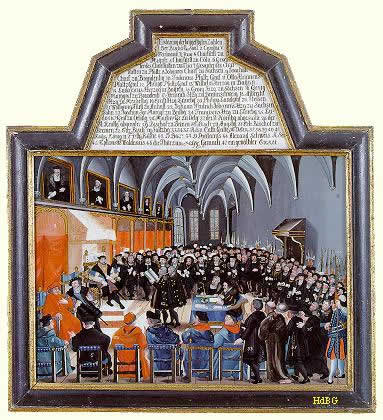1. Introduction
Characteristic of the Reformation as a whole in the 16th and 17th centuries are the confessional texts. This is the case both for the Lutheran and for the Reformed Reformation. In the confessions the churches of the time make known to themselves and all others its doctrine – its perception of the essential content of the Christian faith. The confessions arose because the reformers and the Protestant communities did not only criticise the Roman Church of the 16th Century in respect of its praxis. For behind the praxis the reformers perceived the prevalence of false doctrines – in the case of purgatory, the office of the Pope, the understanding of works and grace, and above all in the understanding of the Bible.
From the Protestant point of view, however, no definitive doctrinal decision, which says for its part exactly what the object of faith is, can be made by an office or person. The Protestants were thus compelled to account for their faith as it were. This occurred externally, for example, in the confessions which were handed over to the emperor at the Augsburg Reichstag in 1530. To these belong the Augsburg Confession (Confessio Augustana) on the Lutheran side and Ulrich Zwingli’s Fidei ratio. More important, however, is the internal function of the confessions: they were used above all for teaching and education in the communities, for example in conjunction with catechisms. A third purpose of the confessions is differentiation from false doctrines.

The Handing over of the Confessio Augustana
at the Augsburg Reichstag
In 1580 in the Lutheran Church there emerged a collection of Lutheran confessional texts which are still valid today. Its core is constituted by the Small and the Large Catechism of Martin Luther and the Confessio Augustana. This collection of seven Lutheran confessional texts serves to unite the Lutheran churches, which refer to them in their doctrinal statements. Although the addition of new confessions was not excluded in 1580, no new Lutheran confession emerged before the 20th Century. And there were and are disputes in the Lutheran churches as to whether the Theological Declaration of Barmen of 1934 can be regarded as a Lutheran confession.
The Reformed confessional texts can be distinguished from the Lutheran confessional texts in respect of both existence and validity. There thus follows first of all a section about the nature of Reformed confessions. In further sections an account of Reformed confessions from Switzerland, France, Germany, West and North West Europe as well as East and South Europe will be given in overview. At stake in the short excerpts from various confessions which have been inserted in the following along with questions is the theme of the “Church”.